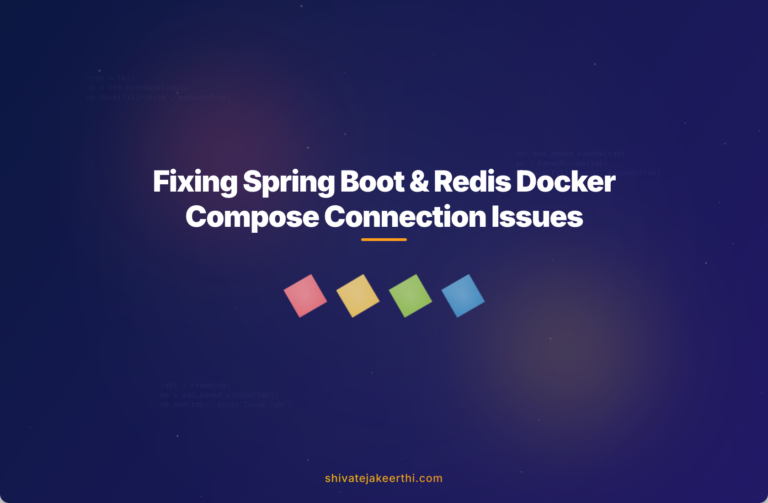Working with Spring Boot alongside Redis in Docker is a great way to streamline your application without worrying about your local environment differences. But encountering connection issues between your containerized Spring Boot app and Redis with Docker Compose is a common hurdle.
When your Spring Boot application can’t reach Redis, it throws error messages like:
io.lettuce.core.RedisConnectionException: Unable to connect to localhost:6379
Such messages indicate that your containerized app isn’t correctly communicating with Redis. Let’s look at the common reasons behind this issue and walk through systematic troubleshooting steps with practical solutions.
Understanding the Redis Connection Error
Usually, this error indicates that your app can’t connect to the Redis service. Inside Docker containers, “localhost” might mean different things compared to running directly on your machine.
Common reasons behind connection failures include incorrect hostnames, wrong port mappings, misconfigured Docker Compose files, or authentication mismatches.
Let’s dissect this step by step to identify what’s causing the issue.
Troubleshooting Spring Boot & Redis Connections in Docker Compose
First, focus on the Docker Compose setup. A typical Docker Compose file for Spring Boot and Redis would look similar to:
version: '3.8'
services:
redis:
image: redis:latest
container_name: redis-container
ports:
- "6379:6379"
myapp:
build: .
container_name: spring-app
ports:
- "8080:8080"
depends_on:
- redis
In the above configuration, Spring Boot (myapp) connects to Redis through the network created by Docker Compose. Notice that “localhost” won’t work in the app’s configuration because the containers maintain separate IP addresses.
Instead of localhost, your app should reference the Redis container name from within your Compose file. In this example, that name is “redis”.
Double-check your Redis service configuration and ensure the correct port mappings. Also, confirm your network configuration is properly set up.
Testing Redis connectivity with Redis CLI
Use Redis CLI to check if Redis is reachable within your Docker network.
First, access an interactive shell inside your Spring Boot container by running:
docker exec -it spring-app sh
Then, test the connection:
redis-cli -h redis ping
If Redis responds with “PONG,” it means the service is running correctly. If not, check authentication or other configuration-related errors.
Analyzing your application.properties file
Your Spring Boot application should connect using valid Redis configuration properties within the application.properties or application.yml file:
spring.redis.host=redis
spring.redis.port=6379
spring.redis.password=your_password_here (if applicable)
Always confirm the Redis host is “redis” instead of localhost or 127.0.0.1 inside a Docker Compose network.
Reviewing Spring Boot Application Logs
Check your Spring Boot app logs for detailed errors. You might discover authentication errors, invalid Redis URLs, or timeout exceptions.
Run the following command to retrieve logs:
docker logs spring-app
Read carefully and solve the exact issues indicated—usually, messages are quite straightforward here.
Additionally, check your Java code for any custom Redis configuration issues. Sometimes, developers embed Redis configuration details within the Java code directly, accidentally overriding the properties file settings.
Practical Solutions for Spring Boot-Redis Connection Errors
If Redis isn’t reachable due to host configuration issues, adjust your Docker Compose configuration. A properly-formatted Compose file with health checks can greatly improve reliability:
version: '3.8'
services:
redis:
image: redis:latest
container_name: redis-container
ports:
- "6379:6379"
healthcheck:
test: ["CMD", "redis-cli", "ping"]
interval: 10s
timeout: 5s
retries: 3
myapp:
build: .
container_name: spring-app
ports:
- "8080:8080"
depends_on:
redis:
condition: service_healthy
Health checks confirm Redis is operational before your app container tries to connect, significantly reducing startup failure issues.
Next, ensure your application.properties has no erroneous references. All Redis settings must match the Docker Compose setup precisely.
Finally, run your Spring Boot application together with Redis containers, and test endpoints using Postman or Curl commands.
Best Practices for Running Spring Boot with Redis in Docker
Once resolved, you want to maintain trouble-free Redis deployment in the Docker environment.
Always secure your Redis instances inside Docker. Consider authentication setups or password protection. An unsecured Redis service is vulnerable to unauthorized access, posing serious security threats.
Here’s how to enforce basic authentication in your Docker Compose:
services:
redis:
image: redis:latest
command: redis-server --requirepass your_password
Reflect this in your Spring Boot properties, too:
spring.redis.password=your_password
Further, limit your network exposure by not exposing Redis ports externally on production environments unless explicitly required.
Monitoring Redis Performance and Health
Integrating monitoring tools such as Prometheus and Grafana helps you continuously track Redis health. Regularly checking Redis logs and metrics also alerts you to issues early.
Set up log aggregation and analysis tools like the Kibana and Elasticsearch stack to manage and monitor application and Redis logs in Docker more effectively.
Wrapping up: Keeping Dockerized Spring Boot & Redis Smooth
Resolving connection issues between Spring Boot and Redis in Docker essentially boils down to correctly referencing Redis hosts, configuring Docker Compose files meticulously, and ensuring consistency across all config files.
Taking these debugging steps seriously saves time down the road. Dockerized applications, especially microservices patterns employing Redis caches, require a practical, methodical approach to configuration.
Remember, running Spring Boot with Redis inside Docker becomes seamless with regular testing and good observability practices.
Are your Spring Boot apps still encountering Docker issues? Share your experiences or questions below, or explore related topics like JavaScript integration for more containerized application techniques.



0 Comments